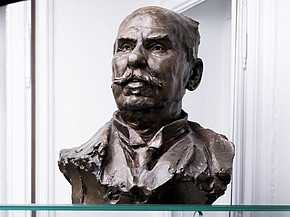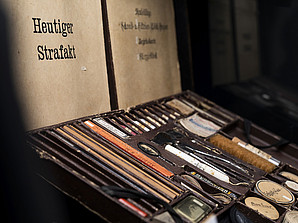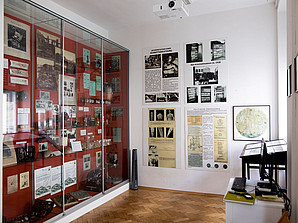From a collection of teaching materials to a university museum
The Hans Gross Museum of Criminology was originally founded by lawyer Hans Gross (1847‒1915) who opened the “Criminal-Museum” in 1895, then located at the regional court for criminal cases in Graz. The collection consisted of corpora delicti and served as a teaching collection for students, lawyers and criminal investigators to train using objects from documented criminal cases. This method of teaching was received with great interest by the wider international criminological community and would go on to be imitated in the USA, Germany and Japan. The collection of various corpora delicti (e.g. weapons, projectiles and poisons) reflects Hans Gross’s passionate enthusiasm for factual evidence.


Crime scene case
His so-called crime-scene suitcase, which is on display at the Hans Gross Museum of Criminology, is a particular highlight of his collection.
It contains tools Hans Gross used to carry out “meticulous investigations” at crime scenes, as he was highly sceptical of the reliability of witness statements. In this way, Gross methodically expanded the way crimes were solved and is therefore considered the Father of Criminology.
Creation of the museum
Hans Gross founded the criminological department at the University of Graz, which was located in the basement of the north wing of the university’s main building. The condition of these rooms was so desolate that in the winter of 1913/1914 Gross had to close down most scientific operations and continue working on his research in his own apartment due to the health-threatening indoor climate.
His successor, Adolf Lenz, moved the collection to the Meerscheinschloss palais, arranging it according to Gross’s system and subdividing it into 32 sections.

In 1980, the collection became part of the Department of Criminal Law, Criminal Procedure Law and Criminology and a dedicated museum was set up in the former St Anna Children’s Hospital in rooms adapted for exhibition purposes.
The Museum of Criminology was integrated into the newly founded cross-faculty platform University Museums in 2010, now welcoming visitors at Heinrichstraße 18 since its reopening in 2018.
Publications
Criminal Investigations, a Practical Textbook
During his many years practising law, Hans Gross came to the conclusion that an investigating judge needed to know more for his work than could be learned from a lecture or a law book.
It is for this reason that he wrote the instructive book Criminal Investigations, a Practical Textbook (Handbuch für Untersuchungsrichter als System der Kriminalistik) in 1893.

The book covers:
- the many different types of crimes
- human nature and the motives of a criminal
- the working methods and approaches of criminals
It also contains advice on how investigating judges ought to conduct their investigations and introduces the concept of a so-called “Komissionstasche” (crime-scene suitcase).
Within just a few years, Hans Gross’s manual on criminology had already been translated into almost all major languages, arousing great interest worldwide. Even the American FBI used his manual.
In 1898, Hans Gross published his book Criminal Psychology (Kriminalpsychologie), detailing his findings on the psychology, behaviours and personalities of offenders.
In addition to the book, he edited and published the first volume of the Archive for Criminal Anthropology and Criminology (Archiv für Kriminalanthropologie und Kriminalistik) to provide up-to-date and ongoing supplementation to the handbook in the same year. (today: Archiv für Kriminologie; German criminology journal)
Contact:
- Adults: EUR 5.00
- Groups (of 8 or more): EUR 3.00 per person
- Family admission: EUR 8.00
- Reduced admission for school groups, children, students, people with disabilities: EUR 2.00
- Reduced admission for people on military or civil service (with ID), or Styrian Senior Citizens Card or SozialCard holders: EUR 3.00